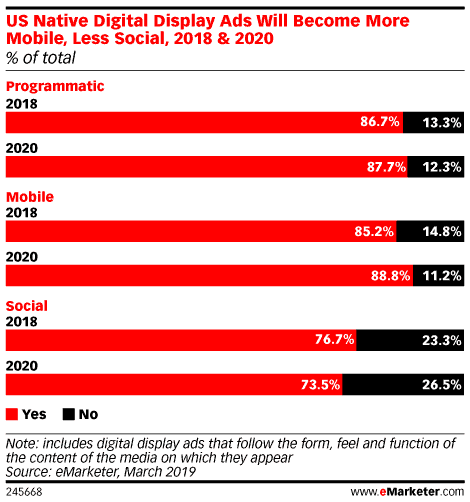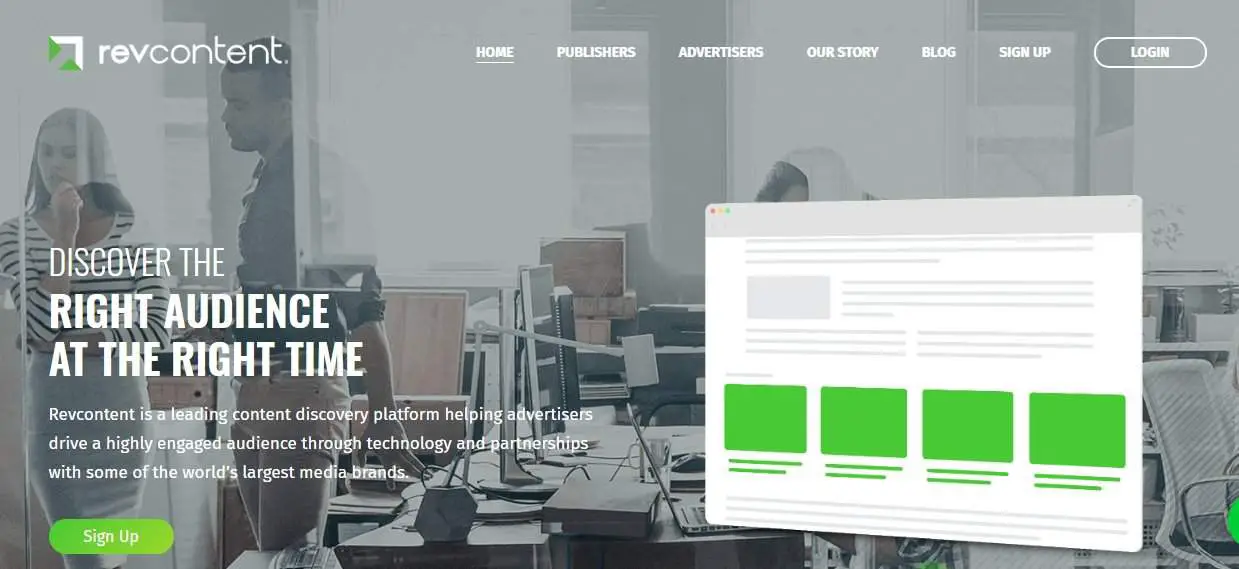Who the heck does use native ads for real estate? Isn’t this an obsolete marketing method?
Well, if that’s the way you think, you might be in for a surprise. But let me first tell you a short story.
A few weeks ago, I checked a weather website and saw an interesting “article” about some fitness device, or so I thought.
I clicked on the “article,” and this fitness device was explained very convincingly.
Only after 1-2 minutes into the article did I realize that I wasn’t reading a “real” article and thought, “wow, well done.”
This wasn’t an article from the weather website. It was a nicely done “editorial” promoting a fitness product blended smoothly on the website.
I am sure you, too, clicked on native ads in the past and read an intriguing piece of content that turned out to be an editorial ad.
Let me ask you something.
Did you know native ads produce a CTR (Click-through rate) of 8.8X compared to typical display ads?
Or that 32% of the respondents of a survey said the native ad “is an ad I would share with a friend or family member” versus just 19% for display ads?
And consumers looked at native ads 53% more frequently than display ads?
So, what will you learn in my today’s article?
We will explore…
- How you can successfully use native ads for your real estate business and generate more leads.
- How you can have a real alternative to Facebook ads or Google ads.
- And how you can take advantage of an underrated but currently more and more growing marketing channel.
But first things first.

What Are Native Ads, and What Are Display Ads?
What happened in my little story from the beginning with the fitness device? I saw something that looked like an article on a weather website and assumed it was such.
But it was an editorial ad that blended very well with the website’s overall design.
And that’s what native ads do.
They are a type of advertising that matches the design, form, and function of the website or platform where they are displayed.
That’s why they are called “native” since they “live” in harmony with the rest of the content.
These ads prevent the website visitor from recognizing them as typical ads.
And by the way, the ads displayed in the Facebook news feed are also native ads because they blend in and pretend to be the usual Facebook posts from your Facebook “friends.”
In contrast, the typical display ad is easily recognized as an advertisement.
They are the most commonly known ones, and the first ones were the banner ads, or hyperlinked image-based ads, and were usually located at the top of a web page.
Later, they took different sizes and shapes and also included videos.
Today, display ads usually have a format of 468 x 60 pixels and a low click-through rate of 0.05%.
But the low click-through rate doesn’t mean they don’t work, although you will have much more work to do to get through to your potential customers due to the “banner blindness.”
Display Ads vs. Native Ads
To compare both types of ads better, you find below a table comparing both.
| Native Ads | Display Ads |
|---|---|
| Soft Sell | Hard Sell |
| High CTR (0.2%) | Low CTR (average 0.05%) |
| Blends into the design of the page’s editorial content | Stands out as advertising |
| More Effective on Desktop | More Effective on Desktop |
| Ideal for driving traffic to your website | Ideal for retargeting campaigns |
Why Native Ads in the Age of Social Media and Why for Real Estate?
Some reasons I’ve already mentioned above.
Native ads are effective because of the following:
- The target audience better receives them.
- They reduce ad fatigue and circumvent banner blindness.
- And they are recognized much later as advertising compared to, for example, display ads (as happened to me).
Your marketing message is more likely to be consumed by your target audience.
They are also more effective because more and more subscription-based platforms allow consumers to receive no advertisement by paying a higher monthly fee.
The advertising these platforms are targeting is usually display ads.
There is also a neuroscientific aspect that makes native ads a great alternative marketing channel.
According to scientists, the human brain hasn’t evolved in 50,000 years.
So, decisions are made the same way as in this far-away past.
And most of the time, marketers tap only into 5 % of the consumer’s conscious part of the brain.
Unfortunately, the other 95% part controls choices, decisions, and actions.
That’s where native ads thrive because they can influence at a subconscious level.
It’s because the website visitor or consumer reads the native ads and becomes part of the experience of consuming relevant content.
So, much more engagement is involved. Both brain hemispheres, including the subconscious, process images and text.
So, Then Why Native Ads for Real Estate?
When selling real estate, your price points are usually six-figure. By that, it’s not the same as selling a lower-priced product such as a fitness device.
For the latter, you can get away with a sales copy that appeals to just one hemisphere of the brain (e.g., emotions).
This is not the case for products with higher price tags, where you ideally should appeal to emotions and rational benefits.
And, as already stated above, native ads engage both hemispheres of the brain, so they are ideally suitable for real estate offers.
What Are Some Native Ad Trends?
The first thing to note is that startups and Fortune 500s are allocating more and more budgets to non-disruptive ad campaigns.
US native ad spending was growing by 20.2% to $52.75 billion in 2018, according to emarketer.
Emarketer also forecasts that in 2020, 88.8% of the native ads in the US will become more mobile (see picture below), and 87.7% will be purchased programmatically.
The native ads coming from social media will decline slightly from 76.7% to 73.5%.

Digital video ad spending has been rising faster than display ads. This is something to take into consideration also for native advertising.
Because according to this article, digital video ad revenue will rise by a compound annual growth rate of 26.6%.
This means that not only text and picture native ads should be considered, but also, or even more so, native video ads.
The Top 4 Largest Native Ads Platforms You Can Start Using Today
So, how do native ad platforms work, and which are out there that you can use today?
Native ad platforms are basically in the traffic arbitrage business.
These platforms acquire different large publishing sites as clients, such as large news websites, large blogs, etc.
They offer them a certain rate (usually on a pay-per-click basis) to include and blend in the publisher’s usual content with the advertiser clients’ “sponsored” content (in this case, your native ad).
Not all publishers are permitted to be part of a native ad platform because specific monthly minimum traffic requirements need to be met.
The Top 4 Largest Native Ads Platforms You Can Use Today
1) Taboola

On Taboola, you can run traffic with prices between $0.02 and $0.10 per click, depending on your click-through rate.
You can choose between the following three different payment schedules:
- Prepayment billing, where you need to pay before you run your campaigns
- Automatic billing with a set billing increment (typically $100), which is the total amount your campaigns can spend before you need to pay again
- Monthly invoice billing with a credit limit
What about audience targeting?
With Taboola, you can target audiences based on behavior, interest, demographics, business, buying intent, and their location (e.g., countries, state, zip codes.)
2) RevContent

Unfortunately, there wasn’t much pricing information available on the platform.
After further research on a third-party site, I learned that the cost per click rate (CPC) depends on geography, and the cost per view can reach $3 for every 1000 impressions.
What about audience targeting?
Not many sniper-style targeting options are available on RevContent. Still, you can target your audience by country, device, and language.
3) AdNow

Your minimum threshold is $20 if you pay via PayPal and $200 should you pay via wire transfer.
Regarding your cost per click, the minimum bid is $0.001, but if you want to get good traffic from tier 1 and tier 2 countries, you will need to bid between $0.1 and $0.5.
What about audience targeting?
The targeting options are the same as the last two native ad platforms.
You can do geo-targeting by country and device targeting.
4) Outbrain

Outbrain is one of the most expensive native ad platforms.
It has publishing partners such as CNN, Time, ESPN, Bloomberg, and more.
You will need a minimum budget for a campaign of $10 per day or $300 per month, and the minimum cost per click (CPC) is $0.03.
As mentioned above, the minimum budget won’t get you much traffic, so you might expect to start between $0.10 and $1.50.
So, you might need between $500 and $2000 per month for a testing budget.
These prices are still less than what you will pay on average per click on Facebook and Google Ads for tier-one countries such as the United States.
This leads me to the last section of this article.

What Do You Pay on Average per Click Right Now for Real Estate Ads on Facebook and Google AdWords?
According to this article on Wordstream, you pay $1.81 per click on average in the real estate industry in tier 1 countries.
In tier 2 countries, this can be way lower, as I know from my experience, where I managed to get the costs down to 5 cents per click on Facebook.
But assuming you are targeting the United States, for the most part, the $1.81 per click is what you will likely have to pay. Of course, this is not set in stone.
If you have a successful campaign with a high CTR and thus can get the cost per click down.
So now, after comparing the costs with Facebook ads for real estate, the first seemingly high cost per click of $1.50 on Outbrain looks a bit different, don’t you think?
What About Google Ads Costs for the Real Estate Industry?
When looking at the costs per click in the real estate industry for search ads on Google, you are looking at whopping costs of $2.37 per click.
But it would be unfair to use this cost per click as a comparison, and it would be better to compare it to the costs per click for Google display ads, which is $0.75 per click.
This is lower than the higher amount of $1.50 on Outbrain but higher than the lower range bit of $0.10.
Even if we ignore the $0.10 and focus on the $1.50 on Outbrain, the cost of Google display ads is only cheaper if you get the same click-through rates as native ads. The latter is highly unlikely.
You might remember the beginning section of this article, where I compared the click-through rates of native ads (0.2%) with display ads (0.05%).
Since the CTR of native ads is four times higher than that of display ads, you can deduce that you have to pay roughly four times more per click for display ads to get the same results as for native ads.
So, if we apply factor 4 to the $0.75 of Google display ads for real estate, we get a cost per click of $3, which we now can fairly compare to the performance of native ads.
This means that even though Google display ads seem cheaper per click at first glance than Outbrain, they are actually more expensive when we factor in the lower click-through rate.
Conclusion
Because of the different advantages native ads give you, with the constantly increasing costs per click for the real estate industry of the most popular advertising platforms such as Google Ads and Facebook, you might give native ads a test try.
Even if it seems that native ads would have more advantages, don’t be misled to believe this is a general conclusion.
As I have mentioned, it depends on many factors, such as your skills with a particular marketing channel.
You usually don’t find by chance a winning marketing channel and a winning campaign. You make them so by repeated testing.
Stay tuned for the next article, where we will dive deeper into the best practices of native ads.
This article has been reviewed by our editorial team. It has been approved for publication in accordance with our editorial policy.
- Why Real Estate Conversion Rates Are 6-Times Below Average - March 21, 2024
- How to Manage Your Apartment Advertising Campaign - February 23, 2024
- Finding Marketing Channels for Apartment Advertising - February 12, 2024

